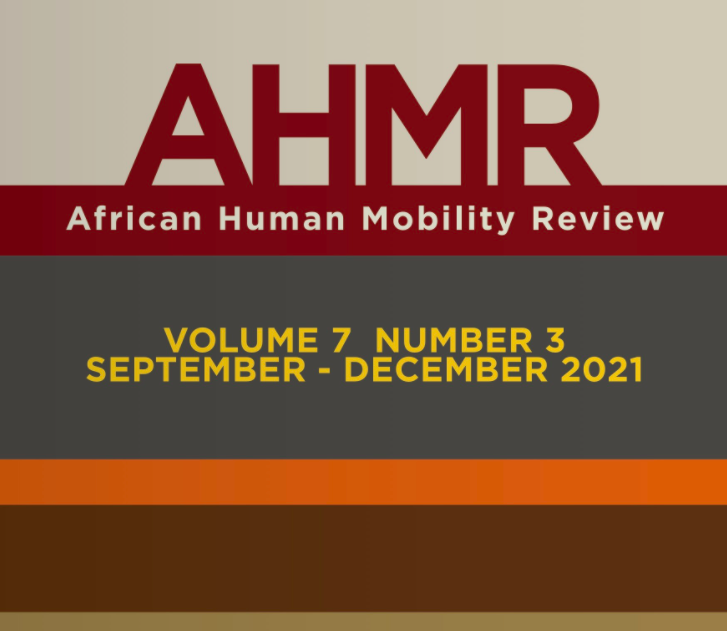
Quick view into African Human Mobility Review Journal (AHMR) Vol 7, No3
Within the next month we’ll be releasing our 1st African Human Mobility Review Journal (AHMR) for 2022. The issue released in December 2021, which was the African Human Mobility Review Journal (AHMR) Vol 7 No3, published 6 different articles related to people on the move. These articles are listed below along with a section of the abstract and commentary taken from the editorial:
Aging, Resilience, and Migration in the Sudano-Sahelian Ecological Belt in Nigeria
Adebayo O.M. Makanju and Alex E. Uriri
“The Sudano-Sahelian Ecological Zone, where natural resources form the foundation of livelihoods and food security, is a critical part of the environmental non-migration discussion. Findings from the trend analysis (2010-2018) revealed that the non-migratory resilience of households was low, although it increased significantly during the examined period.”
The first article looks at the relationship between environmental changes and non- migration outcomes, and suggests that the government develop effective environmental and socioeconomic policies to reduce environmental change and improve aging people's resilience in the future.
Surviving Human Trafficking: A Case for Strengthening the Escape Routes Adopted by Victims of Trafficking in Uganda
Jacqueline Nakaiza
“Efforts to support people who are still trapped in trafficking situations are generally non-existent. This paper reports the findings of a study that attempted to respond to the need to support these people by generating information on the routes by which victims of trafficking in Uganda escape bondage.”
This article explores the routes used by victims of trafficking in Uganda, and the different factors that supported their escape.
The Conundrum of Birth Tourism and American ‘Jackpot Babies’: Attitudes of Ghanaian Urban Dwellers
Ada Adoley Allotey and Leander Kandilige
“Some contemporary international migration literature highlights the practice of the acquisition of privileged citizenship by temporary migrants who give birth in a country other than their home country (birth tourists) and the inherent benefits that accrue to this category of migrants. This study employed concurrent triangulation design to collect data from 260 urban dwellers in three metropolises in Ghana – Accra, Cape Coast, and Kumasi – who were yet to give birth in the United States and 15 parents who already had a total of 25 American ‘jackpot babies’, to measure a broader spectrum of attitudes toward this phenomenon.”
This study gives insight into the desire of urban inhabitants in developing countries to have so-called ‘American jackpot babies’ which has led to the phenomenon known as ‘birth tourism’.
Impact of Subnational Migration Flows on Population Distribution in Kenya: Analysis Using Census Data
Mary Muyonga, Alfred Otieno and George Odipo
“This study sought to analyze subnational migration flows and their impact on population redistribution in Kenya. The study used 1999 and 2009 census micro data to generate migration intensities for each county and to map these using ARCGIS software, to show the distributional effects of migration on the population for the period of investigation. The findings confirm a shift in the migration patterns in the country over the ten-year period, and also on the effect on population redistribution in the country.”
This study investigates subnational migrant movements and how they affect population redistribution in Kenya. The study concludes that internal migration efficiently contributes to population redistribution; however, the effect is diminishing as more regions become urbanized.
The State, Families and Disappeared Migrants in Ethiopia
Tekalign Ayalew
“Regardless of the migration route they pursue, thousands of Ethiopian migrants have died or gone missing. Despite the ubiquitous and regular coverage of migrant deaths in global media, there is limited understanding of the impacts that these deaths and disappearances have on their loved ones and the roles of the state in preventing risky migration that leads to disappearance during fatal journeys.”
According to the findings of this study, despite the presence of national laws and resources dedicated to migration management, as well as the adoption of relevant international human and migrant rights conventions, the domestic legal and policy framework does not directly address the phenomenon of missing migrants and the needs and concerns of their families.
The Dynamics of Child Trafficking in West Africa
Samuel Kehinde Okunade and Lukong Stella Shulika
“The West African region has perpetually maintained the undignified position as the region with the most prevalent issues of human trafficking, child labor, and modern slavery, despite the efforts by the various national governments and the Economic Community of West African States (ECOWAS) to eradicate these atrocities. This study examines the efforts of the West African states towards tackling this menace of trafficking across West African borders.”
ACCESS THE FULL JOURNAL HERE: https://sihma.org.za/journal/ahmr-volume-7-number-3-september-december-2021-1
Categories:
Tags:

